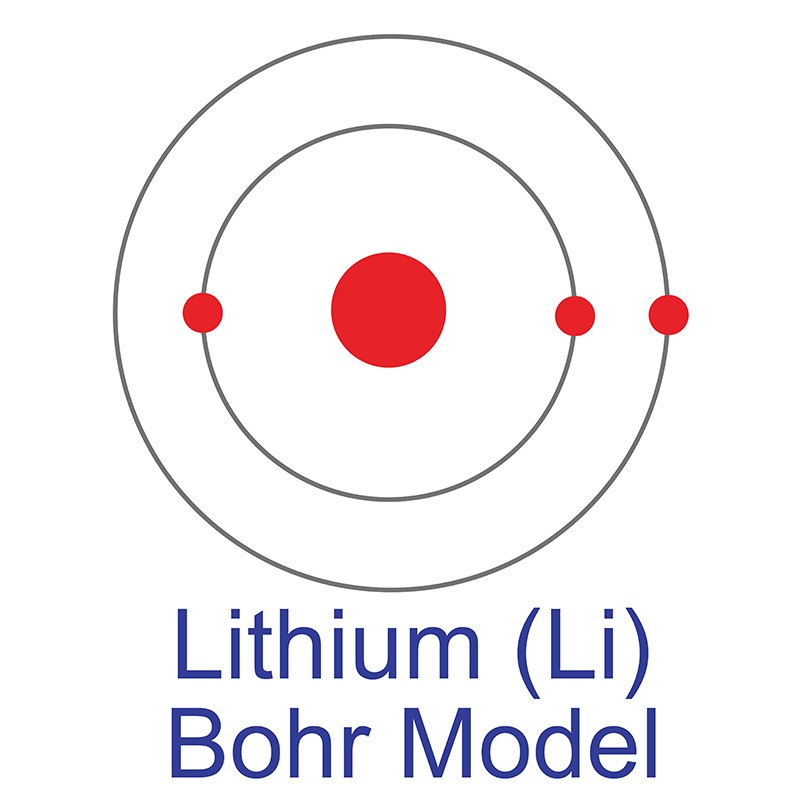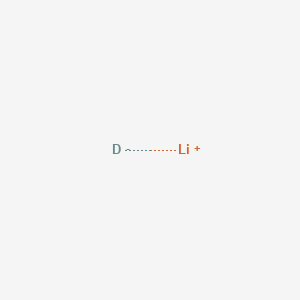SECTION 1. IDENTIFICATION
Product Name: Lithium Deuteride
Product Number: All applicable American Elements product codes, e.g. LI-HD-02
, LI-HD-03
, LI-HD-04
, LI-HD-05
CAS #: 13587-16-1
Relevant identified uses of the substance: Scientific research and development
Supplier details:
American Elements
10884 Weyburn Ave.
Los Angeles, CA 90024
Tel: +1 310-208-0551
Fax: +1 310-208-0351
Emergency telephone number:
Domestic, North America: +1 800-424-9300
International: +1 703-527-3887
SECTION 2. HAZARDS IDENTIFICATION
Classification
This chemical is considered hazardous by the 2012 OSHA Hazard Communication Standard (29 CFR 1910.1200)
Substances/mixtures which, in contact with water, emit flammable gases - Category 2
Label Elements
Signal Word:
Danger
Hazard Statements
In contact with water releases flammable gas
Precautionary Statements
Prevention
Keep away from any possible contact with water, because of violent reaction and possible flash fire
Handle under inert gas. Protect from moisture
Wear protective gloves/protective clothing/eye protection/face protection
Skin
Brush off loose particles from skin. Immerse in cool water/wrap with wet bandages
Fire
In case of fire: Use CO2, dry chemical, or foam for extinction
Storage
Store in a dry place. Store in a closed container
Disposal
Dispose of contents/container to an approved waste disposal plant
Hazards not otherwise classified (HNOC)
None identified
SECTION 3. COMPOSITION/INFORMATION ON INGREDIENTS
Component - Lithium (2H)hydride
CAS-No - 13587-16-1
Weight % - 99
SECTION 4. FIRST AID MEASURES
Eye Contact Immediate medical attention is required. Rinse immediately with plenty of water, also under the eyelids, for at least 15 minutes.
Skin Contact Wash off immediately with soap and plenty of water while removing all contaminated
clothes and shoes. Get medical attention. Take off contaminated clothing and shoes immediately.
Inhalation Remove from exposure, lie down. Remove to fresh air. If not breathing, give artificial
respiration. Immediate medical attention is required.
Ingestion Never give anything by mouth to an unconscious person. Drink plenty of water. Call a
physician immediately. If possible drink milk afterwards.
Most important symptoms and effects
No information available.
Notes to Physician Treat symptomatically
SECTION 5. FIREFIGHTING MEASURES
Unsuitable Extinguishing Media No information available
Flash Point No information available
Method - No information available
Autoignition Temperature No information available
Explosion Limits
Upper No data available
Lower No data available
Sensitivity to Mechanical Impact No information available
Sensitivity to Static Discharge No information available
Specific Hazards Arising from the Chemical
Contact with water liberates toxic gas. Water reactive. Produce flammable gases on contact with water.
Hazardous Combustion Products
Thermal decomposition can lead to release of irritating gases and vapors.
Protective Equipment and Precautions for Firefighters
As in any fire, wear self-contained breathing apparatus pressure-demand, MSHA/NIOSH (approved or equivalent) and full protective gear.
NFPA
Health
0
Flammability
2
Instability
1
Physical hazards
W
SECTION 6. ACCIDENTAL RELEASE MEASURES
Personal Precautions Ensure adequate ventilation. Use personal protective equipment as required.
Environmental Precautions See Section 12 for additional Ecological Information.
Methods for Containment and Clean
Up
SECTION 7. HANDLING AND STORAGE
Handling Avoid contact with skin and eyes. Avoid contact with skin and clothing. Remove and wash
contaminated clothing and gloves, including the inside, before re-use. Avoid breathing vapors or mists. Do not ingest. If swallowed then seek immediate medical assistance. Wash thoroughly after handling.
Storage Keep from any possible contact with water. Store under an inert atmosphere. Keep away
from water or moist air.
SECTION 8. EXPOSURE CONTROLS/PERSONAL PROTECTION
Exposure Guidelines This product does not contain any hazardous materials with occupational exposure limitsestablished by the region specific regulatory bodies.
Engineering Measures Ventilation systems.
Personal Protective Equipment
Eye/face Protection Wear appropriate protective eyeglasses or chemical safety goggles as described by OSHA's eye and face protection regulations in 29 CFR 1910.133 or European Standard EN166.
Skin and body protection Wear appropriate protective gloves and clothing to prevent skin exposure.
Respiratory Protection No protective equipment is needed under normal use conditions.
Hygiene Measures
Handle in accordance with good industrial hygiene and safety practice.
SECTION 9. PHYSICAL AND CHEMICAL PROPERTIES
Physical State Solid
Appearance No information available
Odor No information available
Odor Threshold No information available
pH No information available
Melting Point/Range 680 °C / 1256 °F
Boiling Point/Range No information available
Flash Point No information available
Evaporation Rate Not applicable
Flammability (solid,gas) No information available
Flammability or explosive limits
Upper No data available
Lower No data available
Vapor Pressure No information available
Vapor Density Not applicable
Specific Gravity 0.820
Solubility No information available
Partition coefficient; n-octanol/water No data available
Autoignition Temperature No information available
Decomposition Temperature No information available
Viscosity Not applicable
Molecular Formula D Li
Molecular Weight 8.96
SECTION 10. STABILITY AND REACTIVITY
Reactive Hazard Yes
Stability Stable under normal conditions. Hygroscopic.
Conditions to Avoid Incompatible products.
Incompatible Materials Strong oxidizing agents
Hazardous Decomposition Products Thermal decomposition can lead to release of irritating gases and vapors
Hazardous Polymerization Hazardous polymerization does not occur.
Hazardous Reactions None under normal processing.
SECTION 11. TOXICOLOGICAL INFORMATION
Acute Toxicity
Product Information No acute toxicity information is available for this product
Component Information
Toxicologically Synergistic
Products
No information available
Delayed and immediate effects as well as chronic effects from short and long-term exposure
Irritation No information available
Sensitization No information available
Carcinogenicity The table below indicates whether each agency has listed any ingredient as a carcinogen.
Developmental Effects No information available.
Teratogenicity No information available.
STOT - single exposure None known
STOT - repeated exposure None known
Aspiration hazard No information available
Symptoms / effects,both acute and delayed
No information available
Endocrine Disruptor Information No information available
Other Adverse Effects The toxicological properties have not been fully investigated.
SECTION 12. ECOLOGICAL INFORMATION
Ecotoxicity
Do not empty into drains.
Persistence and Degradability No information available
Bioaccumulation/ Accumulation No information available.
Mobility No information available.
SECTION 13. DISPOSAL CONSIDERATIONS
Waste Disposal Methods Chemical waste generators must determine whether a discarded chemical is classified as a hazardous waste. Chemical waste generators must also consult local, regional, and national hazardous waste regulations to ensure complete and accurate classification.
SECTION 14. TRANSPORT INFORMATION
DOT
UN-No UN1414
Hazard Class 4.3
Packing Group I
TDG
UN-No UN1414
Hazard Class 4.3
Packing Group I
IATA
UN-No UN1414
Proper Shipping Name LITHIUM HYDRIDE
Hazard Class 4.3
Packing Group I
IMDG/IMO
UN-No UN1414
Proper Shipping Name LITHIUM HYDRIDE
Hazard Class 4.3
Packing Group I
SECTION 15. REGULATORY INFORMATION
United States of America Inventory
Component Lithium (2H)hydride
CAS-No 13587-16-1
TSCA -
TSCA Inventory notification -Active/Inactive -
TSCA - EPA Regulatory Flags -
International Inventories
Canada (DSL/NDSL), Europe (EINECS/ELINCS/NLP), Philippines (PICCS), Japan (ENCS), Australia (AICS), China (IECSC), Korea (ECL).
Component Lithium (2H)hydride
CAS-No 13587-16-1
DSL -
NDSL -
EINECS - 237-018-5
PICCS -
ENCS -
AICS - Listed
IECSC -
KECL -
U.S. Federal Regulations
SARA 313 Not applicable
SARA 311/312 Hazard Categories See section 2 for more information
CWA (Clean Water Act) Not applicable
Clean Air Act Not applicable
OSHA - Occupational Safety and Health Administration Not applicable
CERCLA Not applicable
California Proposition 65 This product does not contain any Proposition 65 chemicals.
U.S. State Right-to-Know Regulations Not applicable
U.S. Department of Transportation
Reportable Quantity (RQ): N
DOT Marine Pollutant: N
DOT Severe Marine Pollutant: N
U.S. Department of Homeland Security This product does not contain any DHS chemical.
Other International Regulations
Mexico - Grade No information available
SECTION 16. OTHER INFORMATION
Safety Data Sheet according to Regulation (EC) No. 1907/2006 (REACH). The above information is believed to be correct but does not purport to be all inclusive and shall be used only as a guide. The information in this document is based on the present state of our knowledge and is applicable to the product with regard to appropriate safety precautions. It does not represent any guarantee of the properties of the product. American Elements shall not be held liable for any damage resulting from handling or from contact with the above product. See reverse side of invoice or packing slip for additional terms and conditions of sale. COPYRIGHT 1997-2022 AMERICAN ELEMENTS. LICENSED GRANTED TO MAKE UNLIMITED PAPER COPIES FOR INTERNAL USE ONLY.
 See more Lithium products.
See more Lithium products. Compared to other metals, it has one of the lowest boiling points. In its elemental form, lithium is soft enough to cut with a knife its silvery white appearance quickly darkens when exposed to air. Because of its high reactivity, elemental lithium does not occur in nature. Lithium is the key component of
Compared to other metals, it has one of the lowest boiling points. In its elemental form, lithium is soft enough to cut with a knife its silvery white appearance quickly darkens when exposed to air. Because of its high reactivity, elemental lithium does not occur in nature. Lithium is the key component of 
